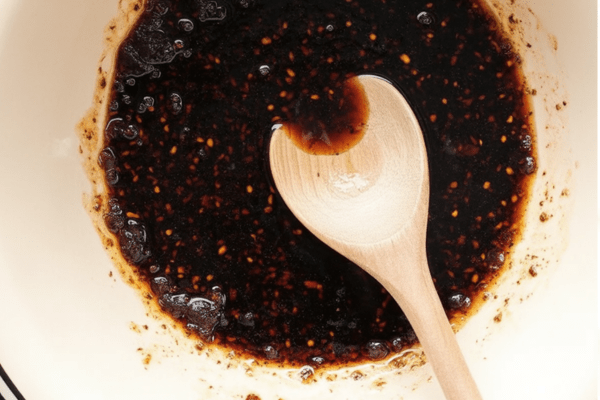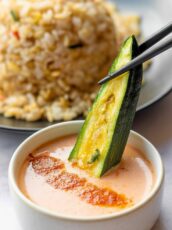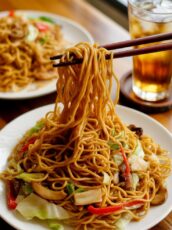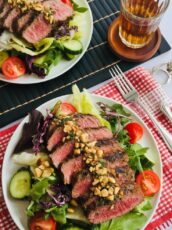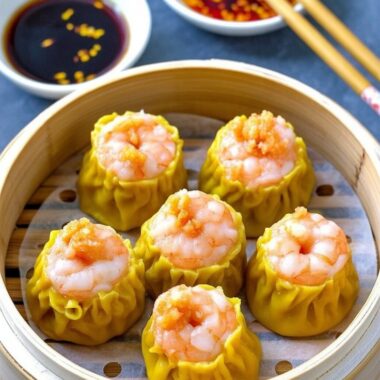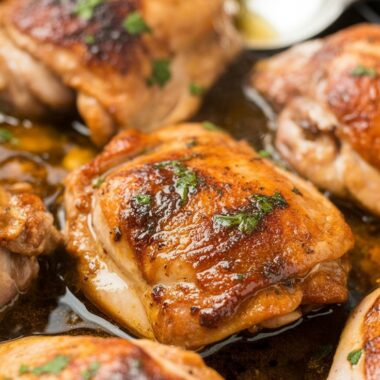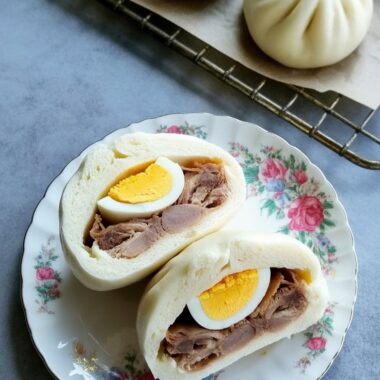Creamy, vibrant, and unmistakably Filipino—Halayang Ube is that sweet treat that always brings me back to family gatherings and childhood memories. This purple yam jam is smooth, rich, and a little bit indulgent, with that familiar tropical note from coconut milk and the surprise creaminess of cheese. It’s one of those desserts that feels like home, whether you serve it as a simple snack, an eye-catching party treat, or even use it in other creations like halo-halo or baked goods.
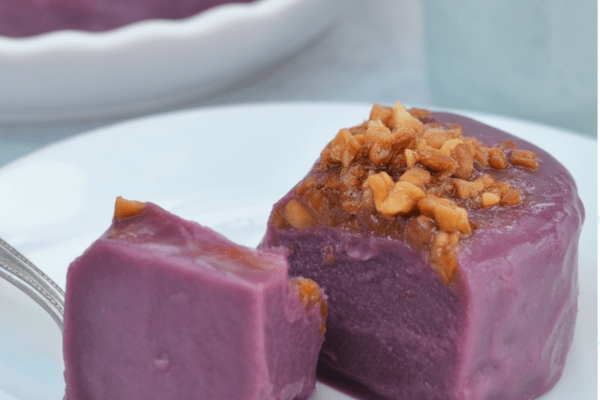
What is Ube Halaya
If you’ve never had Ube Halaya before, think of it as the Philippines’ answer to jam—except it’s made with purple yam. It’s dense, creamy, and sweet, with a gorgeous purple color that makes everyone at the table do a double-take.
At home, we’d often have it as a merienda (afternoon snack) spread on bread or served as slices on a plate, topped with toasted coconut or latik (those addictive coconut milk solids). But it’s so much more versatile—you can swirl it into bread dough, stuff it into pastries, add it to crinkle cookies, or layer it into halo-halo. I even love folding it into no-churn ice cream. It’s that one ube treat that every Filipino household seems to have a version of, and everyone swears theirs is best.
Ingredient Notes
Purple Yam (Ube)
The star of the show! Traditionally, you’d steam or boil whole purple yams until they’re tender, then mash them smooth. But I’ll be honest—these days I often use frozen grated ube from the Asian store because it’s such a time-saver and just as good. If you’re making this from fresh yam, make sure to mash thoroughly so you don’t get any lumps.
Milk, Butter, and Sugar
This is where the magic happens. Coconut milk lends that unmistakable tropical note, while evaporated milk and condensed milk make the mixture creamy and sweet. The butter adds richness and helps achieve that glossy finish. I like to use good-quality butter, even if it feels a bit extra—it makes a difference.
Cheese
This might sound odd if you’ve never tried it, but processed cheese (like the typical American cheese blocks we get here) melts beautifully into the mixture, making it extra creamy and helping it set up nicely. It’s one of those little secrets that make ube halaya irresistible.
Ube Extract
Optional but recommended. Just a few drops go a long way. It boosts the color (though the purple will deepen as it cooks) and adds that signature ube aroma that feels so nostalgic to me. But don’t overdo it—it can turn neon if you’re not careful.

How to Make Ube Halaya
Making ube halaya is wonderfully simple, but I’ll warn you—it’s an arm workout. You need to stir constantly to prevent burning, and it can take a while to reach the perfect thick consistency. I often put on a favorite playlist or chat with whoever’s in the kitchen to pass the time.
Here’s how I do it:
- In a wide, heavy pan, combine the grated ube, coconut milk, condensed milk, evaporated milk, butter, and sugar. Whisk everything together until it’s smooth.
- Bring it to a gentle boil, making sure the sugar dissolves and butter melts. If you’re using ube extract, add it now and stir until the color is evenly distributed.
- Lower the heat and simmer. Here’s the part where you need patience—stir constantly so it doesn’t scorch. You’re aiming for a thick, paste-like consistency that starts pulling away from the sides.
- Add in the cheese, stirring until it melts completely into the mix. Keep cooking and stirring until you can run a spoon through and it holds shape.
- Grease a mold or baking dish lightly with coconut oil or butter. Spoon in the hot mixture and press it down evenly with a greased spatula.
- Let it cool completely before serving. Once cooled, invert onto a plate and brush lightly with coconut oil. Top with latik (crispy coconut curds), shredded cheese, toasted coconut, or sweetened coconut strips if you want to dress it up.
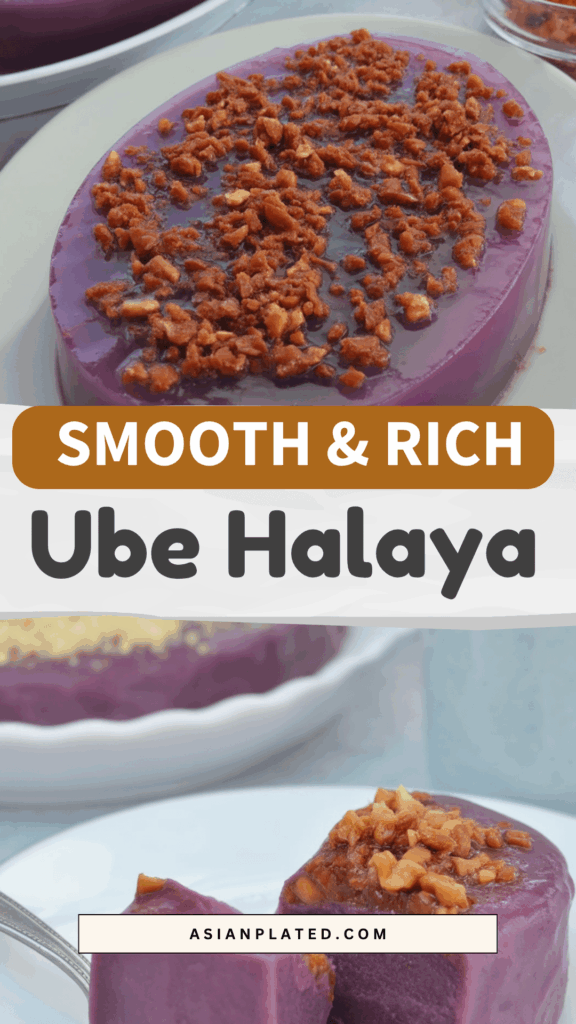
Quick Tip
One thing I learned over the years: you can adjust how thick you cook it depending on how you want to serve it. If you’re storing it in jars to spread on toast, leave it a bit looser and more spreadable. If you want those nice, sliceable blocks, cook it longer until really thick. Remember, it will firm up more as it cools, so don’t overdo it thinking it’s too runny while hot.
Serving Suggestions
I love serving Ube Halaya in slices on a pretty plate, brushed with coconut oil for shine and topped with latik for that nutty crunch. It’s perfect on its own, but don’t stop there!
For parties, I often make small molded portions in llaneras (Filipino molds) or ramekins so everyone gets their own fancy piece.
You can also use it to fill bread rolls, swirl into cheesecakes, or scoop onto halo-halo for that ultimate summer treat. It’s truly one of those recipes that never goes to waste in my kitchen.
How Long Does Ube Halaya Last
Freshly made, your halaya will keep well in the fridge for about 3 days. Just make sure you store it in an airtight container to keep it from drying out or absorbing other fridge smells.
For longer storage, I often portion it and freeze it—it lasts up to a month that way. When I want a bit, I just thaw it overnight in the fridge.
If you’re planning on gifting jars of it or want to keep it even longer, you can research safe canning methods. But honestly, it never lasts long enough in my house to need that!
Ube Halaya

Ube Halaya is a beloved Filipino treat that's perfect as a snack or dessert. Creamy, cheesy, and full of purple yam flavor, it's sure to delight any crowd.
Ingredients
- 1 package (16 ounces) frozen grated ube, thawed
- 1 can (13.5 ounces) coconut milk
- 1 can (14 ounces) sweetened condensed milk
- 1 can (12 ounces) evaporated milk
- ½ cup butter
- 1 cup sugar
- 2 to 3 drops ube extract (optional)
- 1 cup American processed cheese, shredded
For the Latik:
- 2 cups coconut cream
Instructions
- In a sturdy, wide saucepan set over medium heat, combine the grated ube with coconut milk, condensed milk, evaporated milk, sugar, and butter. Stir occasionally to help the sugar dissolve and the butter melt, ensuring the ube is smoothly incorporated into the mixture.
- As the mixture begins to bubble and everything is well mixed, you may add a few drops of ube extract to enhance the color, if desired. Reduce the heat and let it simmer, stirring regularly to prevent sticking. Continue cooking until the mixture thickens into a dense, sticky consistency—this usually takes about 30 to 40 minutes.
- Add the shredded cheese and continue stirring until it melts completely and blends with the mixture. Let it cook for an additional 10 to 15 minutes, or until it becomes thick enough to coat the back of a spoon and starts pulling away from the sides of the pan.
- Lightly brush a dish or mold with melted butter or coconut oil to prevent sticking. Transfer the cooked ube mixture into the prepared container, using a greased spatula to spread and smooth the surface evenly. Leave it to cool completely at room temperature.
- Once the halaya has set, gently remove it from the mold and place it on a serving plate. For a more polished appearance, lightly brush the surface with coconut oil and top it with your choice of garnish, such as latik, grated cheese, toasted coconut, or sweetened macapuno.
- To make latik, heat coconut cream in a pan over medium heat and bring it to a gentle boil. Allow it to simmer until it thickens and begins to release oil. Lower the heat and stir frequently as curds form. Scrape the bottom and sides of the pan to prevent burning.
- Continue cooking until the curds turn golden and crisp. Once ready, separate the solids from the coconut oil by straining. Store the crunchy latik and coconut oil separately until ready to use.
Notes
- The purple yam jam can be cooked to a spreadable consistency for storing in jars, or until thick enough to mold. Simply extend the cooking time as needed. It will continue to thicken as it cools.
Nutrition Information:
Yield: 12 Serving Size: 1Amount Per Serving: Calories: 398Total Fat: 21gSaturated Fat: 16gTrans Fat: 1gUnsaturated Fat: 4gCholesterol: 39mgSodium: 349mgCarbohydrates: 48gFiber: 0gSugar: 47gProtein: 5g
Asianplated.com, occasionally offers nutritional information for recipes contained on this site. This information is provided as a courtesy and is an estimate only. This information comes from online calculators. Although allchickenrecipes.com attempts to provide accurate nutritional information, these figures are only estimates.
FAQs
Can I use fresh ube instead of frozen?
Absolutely! Just steam or boil it until fork-tender, then mash until completely smooth. It takes a bit more time, but it’s worth it if you have access to fresh ube.
Do I need the ube extract?
Not strictly—but it does help with that vivid color and signature aroma. If you want a more natural look and taste, feel free to skip it or use very little.
Why add cheese? Isn’t that weird?
It might sound strange if you didn’t grow up with it, but trust me—it makes the halaya extra creamy and gives it that rich, melt-in-your-mouth finish. It’s a classic Filipino touch that I never skip.
How do I keep it from burning?
Low heat and constant stirring are key. I use a heavy-bottomed pan to distribute the heat more evenly. Don’t rush it. Slow and steady wins the race!
If you’ve never tried making Halayang Ube at home, I really encourage you to give it a go. It’s a little labor of love, but so rewarding. It’s one of those recipes that always makes people’s eyes light up when you bring it to the table, and it has a way of making any occasion feel special. Let me know if you try it—I’d love to hear how you make it your own!
Try other recipes:


